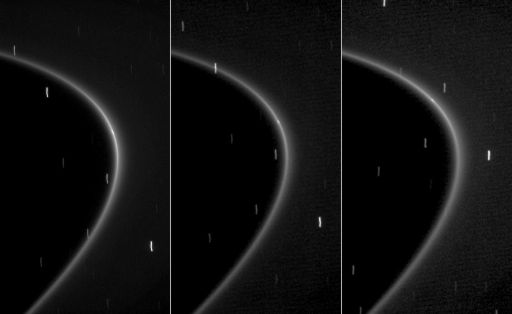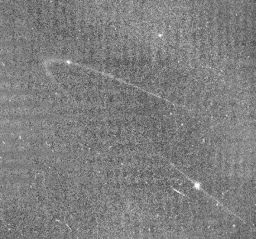Emily Lakdawalla • Mar 03, 2009
A new moon for Saturn within the G ring
UPDATE: This new moon is now named Aegaeon.EDIT: Check out a correction posted on March 4: Cassini definitely could and may well get images of this newly discovered moon.
It's been a while since the last discovery of a moon at Saturn by Cassini; today comes a long-awaited announcement, the discovery of the parent body (perhaps just one of several) to Saturn's dusty G ring. It's long been suspected that there must be something responsible for the presence of that ring, but until now no one's been able to find the responsible moonlet. There's a good reason it was hard to find: they are guessing that the tiny thing is only about half a kilometer across, the size of Itokawa. It's provisionally named S/2008 S1, and its existence was announced today in the International Astronomical Union Circular #9023. My subscription to the IAUCs seems to have lapsed, so I don't know what other details are in the citation, unfortunately. Here's a set of photos:

NASA / JPL / SSI
New moon of Saturn within the G ring: S/2008 S1
This series of images was captured by Cassini over a period of 10 minutes and follows the path of a newly discovered moonlet within Saturn's dusty G ring. The images were taken with long exposures, so background stars form streaks. At the same time, the ring was orbiting Saturn, so it is also streaked, but in the direction of orbital motion. Within the G ring in each image is a small streak of light: this is the reflected light of the moonlet S/2008 S1. The images focus on an extremely tiny portion of the G ring, and when enlarged, show it at 7 kilometers per pixel. The moonlet itself is only about 500 meters across, far smaller than a single pixel in these images.
NASA / JPL / Space Science Institute
An arc in Saturn's G ring
These three images of the tenuous G ring were taken by Cassini about 45 minutes apart on May 24, 2005. In the first image, a bright arc is visible at the bottom edge of the ring. In the middle image, the bright arc has rotated around to the ansa (left side) of the ring. In the right image, the arc has moved up and to the right. The origin of this arc was then unknown.
NASA / JPL / SSI
Methone and Anthe with their ring arcs
Arcs of material share an orbit with the tiny moons Anthe (top left) and Methone (bottom right). The arcs are confined by resonances with Mimas; the Methone arc only spans about 10 degrees of longitude, and the Anthe arc about 20 degrees of longitude.
from Matt Hedman's presentation to the 2008 DPS meeting
Ring arcs associated with small moons of Saturn
Methone, Anthe, and Pallene are very small moons that were discovered in Cassini images of the region between Mimas and Enceladus, in orbit around Saturn. Further investigation of these moons has yielded the discovery of rings associated with these moons -- ring arcs for Anthe and Methone, and a complete ring for Pallene.S/2008 S1 may just be the easiest to find of a number of parent bodies that supply dusty material to the G ring. Methone, Anthe, and Pallene just have arcs, but the G ring extends all the way around the planet. So there could well be other objects, maybe just 100 meters or 50 meters across, orbiting in different positions within the G ring, all supplying the dust that keeps the G ring its dusty self. With this discovery, I think Cassini's beginning to venture into the murky terrain that separates "moons" from "ring particles."
What would S/2008 S1 look like up close? I don't know, but I can hazard some guesses. It's roughly the size of Itokawa, but I would think that it wouldn't look anything like Itokawa's bouldery and gravelly surface. S/2008 S1 orbits within an arc of dust of all sizes. The small moons of Saturn that orbit close to and within the rings that Cassini has photographed -- Atlas, for instance, or Pandora -- have odd football (American football, that is, or rugby ball, if you prefer) or saucer shapes, formed from the slow accretion and sliding of dust around their surfaces. I'd guess S/2008 S1 would look like that. Try to land on it, and your every motion would kick up puffs and clouds of dust, flying away on ballistic trajectories, to orbit Saturn in the "sky" around the little world. Weird.
Support our core enterprises
Your support powers our mission to explore worlds, find life, and defend Earth. You make all the difference when you make a gift. Give today!
Donate

 Explore Worlds
Explore Worlds Find Life
Find Life Defend Earth
Defend Earth

